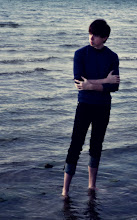Well it has certainly been some time since I last updated.
Apologies are due i'm sure, but as last semester came to a close, things got a little hectic, and I had overloaded my schedule with a concept art class that kicked my butt since I didn't have great figure or drawing classes my freshmen year, so I kinda lost track with new posts.
Summer of course, was a nice refresher, gave me time to get outdoors and do some good old man's man work as a landscaper.
Now it is a month into Junior year and time to post the new work! Let me get you up to speed with last semester's stuff of course, continuing approx. where I left off.
Design with Type II:
Longscycle Redesign
We were tasked with remaking a pretty horridly designed website called "Longscycle.com" a retailer in bike equipment. This was never designed functionally, simply Adobe Illustrator and Indesign mock ups that showed the improved layout and navigation systems. It was about reduction, simplification, just ways to make a website pleasing to the eye and easy to follow.
I used yellow to bring to mind Lance Armstrong, who's corporate imagery is strongly associated with bicycling these days. It brings an air of professionalism that the website drastically needed.
I liked the alternating black and yellow highlights on the links that got navigated, I feel it would've been pretty interesting had the professor wanted us to make a working website. I wanted to use more symbols and icons for buttons instead of text as that is simpler, but they felt it was unnecessary. After all, it was a Typography class. The only icon I made that survived was the Shopping Cart. Ohwell.
Type In Space
The award to most design iteration changes definitely goes to this project.
The assignment involved picking from a couple of design events that occurred at several different museums and making a typographic poster that utilized three dimensions or otherwise involved motion in some way that sponsored the event.
My first staircase concept was a little too hectic with the information, so I made sure to simplify it. A big problem was the sheer number of things that had already been done from previous examples that she gave us. There was only so much I felt I could do with isometrics. Eventually I strayed away from 3-d altogether, the class as a whole was doing more motion based pieces and because they consistently didn't like what I was showing, I decided to be a sheep and follow along with what they were doing.
The yellow one was what I settled on. Another color scheme might've been better. I think the purple and black rectangles could've worked, the professor didn't care much for the font though, and I didn't really care for the concept with a conventional font. I still think the one with intersecting planes was neat as well as the one with white accents around the text.
New Media:
Don't feel like doing screen grabs of this website, but I feel this guy was pretty successful.
Flash required to view.
We had to make a six-page website that extrapolated upon a six-sided package of our choice, one box side equals one webpage. I did Orbit Gum. The buttons were meant to be unique but understandable, I decided to make them sticks of gum inside a package, and model each page on a different flavor.
The "Cinnamint" flavor was supposed to have moving fire-esque flames in the background, but that was troublesome to animate and I wasn't the best at budgeting time last year. I've improved on that aspect of myself a lot for this year.
Graphic Design II:
Book I
These are some page excerpts from the first book I had to make in Graphic Design II. I had some exercises that played with the icon back in my posts in february, but here are some of the finalized pieces. I loved trying to photoshop the icon into actual places, check back into the february posts to see some of the other variations I tried. My craft on the actual book was not very successful however...
Oh, and the photos that I manipulated is not my own. The teachers explained we are allowed to take photos and use them for our projects as long as we don't start selling them. Just an fyi.
Book II
Book II involved taking our Icon and really pressing the idea as far as we could. We started with indexs which is a term used to describe the footprint of something, such as the snow print to the animal paw. We had to come up with large compositions that had imagery, a word, and a poem or phrase that all had an overarching relation.
This book didn't have much of new content, instead focusing heavily on the process of building up to our six final compositions. I didn't find my earlier works to be of much interest, so these are the six final concepts that relate to my Fluorescent Light Bulb icon shown earlier.



















































